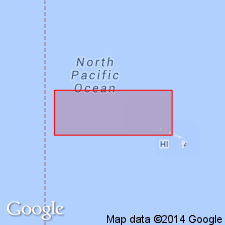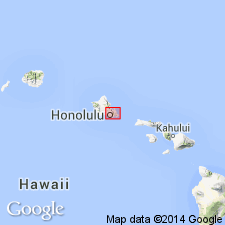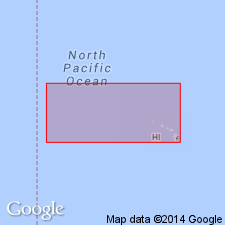
- Usage in publication:
-
- Makawao breccia*
- Modifications:
-
- Named
- Dominant lithology:
-
- Breccia
- AAPG geologic province:
-
- Oahu
Summary:
Named for Makawao Stream. Occurs at Maunawili Ranch 2.5 mi S and a little W of Olomana Peak [Koko Head 7.5' quad] Island of Oahu. Included as unit in lower part of Honolulu volcanic series. Consists of firmly cemented dark gray breccia containing blocks of Koolau basalt 3 ft in diameter and beds of fine-grained brown tuff in Makawao Stream bed and also tuff in banks of Maunawili Stream near Maunawili Ranch Breccia is more than 200 ft thick. Unconformably overlies Koolau volcanic series. Tuff at Maunawili Stream is intercalated with alluvium underlying Ainoni volcanics. Since no dikes were injected into breccia, unit is tentatively considered post-Koolau age and assigned to Kaena stand of sea. Assigned to middle(?) and late Pleistocene age.
Source: GNU records (USGS DDS-6; Menlo GNULEX).

- Usage in publication:
-
- Makawao breccia*
- Modifications:
-
- Revised
- AAPG geologic province:
-
- Oahu
Summary:
Makawao breccia of Honolulu volcanic series (of Stearns, IN Stearns and Vaksvik, 1935) is considered more closely allied to Koolau volcanic series based on lithology and difficulty in determining age.
Source: GNU records (USGS DDS-6; Menlo GNULEX).

- Usage in publication:
-
- Makawao breccia*
- Modifications:
-
- Age modified
- AAPG geologic province:
-
- Oahu
Summary:
Main patch of breccia is 0.5 mi long and 0.25 mi wide, 1.75 mi south-southwest of Olomana Peak on northeast side of Koolau Range 8 mi northwest of Makapuu Head. No fossils. Because of unconformable relationships with Koolau volcanic series and since tuff is intercalated with alluvium underlying Ainoni volcanics, unit probably formed during plus 95-foot (Kaena) stand of sea. Assigned Pleistocene age.
Source: GNU records (USGS DDS-6; Menlo GNULEX).

- Usage in publication:
-
- Makawao Breccia†
- Modifications:
-
- Abandoned
- AAPG geologic province:
-
- Oahu
Summary:
Makawao Breccia (Stearns, IN Stearns and Vaksvik, 1935) abandoned as formally named unit and called Makawao tuff and breccia deposits, informal unit in Honolulu Volcanics.
Source: GNU records (USGS DDS-6; Menlo GNULEX).
For more information, please contact Nancy Stamm, Geologic Names Committee Secretary.
Asterisk (*) indicates published by U.S. Geological Survey authors.
"No current usage" (†) implies that a name has been abandoned or has fallen into disuse. Former usage and, if known, replacement name given in parentheses ( ).
Slash (/) indicates name conflicts with nomenclatural guidelines (CSN, 1933; ACSN, 1961, 1970; NACSN, 1983, 2005, 2021). May be explained within brackets ([ ]).

